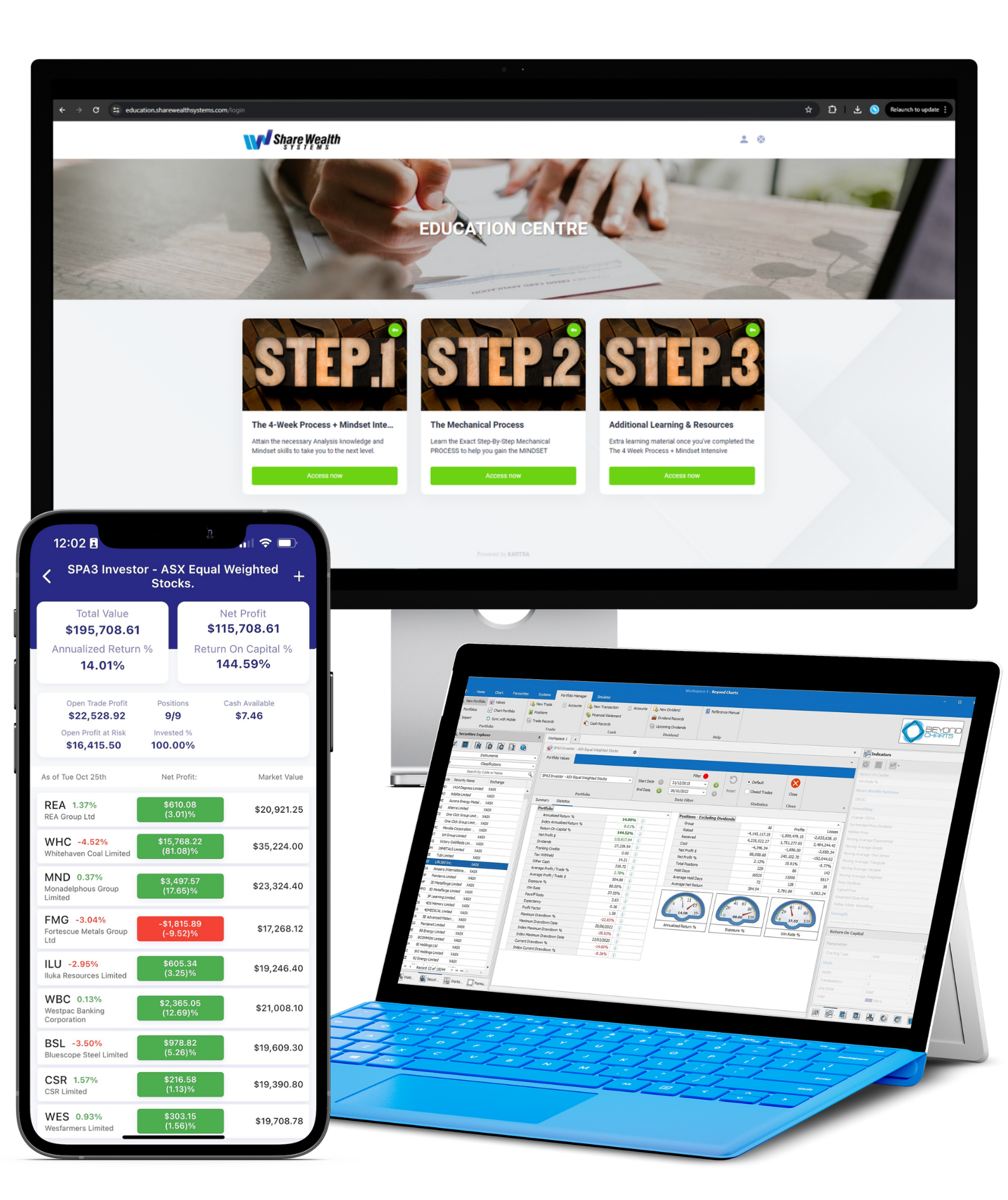
In last week’s article, I explained why timing the market is a strategy that, if set up and executed correctly, has the greatest potential to get you long-term market-beating returns.
And when I talked about the must-have elements for creating such a strategy, I mentioned the “Statistical Edge.”
In fact, I said that without a positive one, your timing strategy is doomed.
That’s how critical having a Statistical Edge is. Yet too many investors either haven’t heard of it or don’t know how to test if they have it.
So, I’ve decided to break down what lies behind the term Statistical Edge. And show you exactly why having one is a must for any self-directed investor wanting to outperform the market in the long run.
Plus, I’ll explain how you can test if your DSS (Decision Support System) has a positive one before you invest a single cent of real money.
Let’s dig into it.
What Is A Statistical Edge And Why Do You Need One
If you don’t plan on using a mechanical DSS with clearly defined buy and sell criteria, you can’t have a Statistical Edge.
Or at least you can’t precisely calculate it.
That’s because a Statistical Edge represents the probability of your timing (buy and sell) rules netting you market-beating profits in the long run. Meaning if you don’t make investing decisions based on such rules…
You can’t determine your edge either.
A Statistical Edge is kind of like your investing IQ. Except instead of relatively indicating how well your brain works…
It shows how good your market timing criteria are.
Notice I said “probability,” not certainty. No set of timing rules will work all the time. But a positive Statistical Edge will stack the odds in your favor.
To better understand the power of a positive Statistical Edge, think of a game of roulette. There, you have a nearly 50/50 chance of winning when betting on black or red.
Except there’s also a zero on the wheel. And it puts the probability on the side of the house, thereby giving them an edge. Meaning the more you play…
The more you lose. And the more the House wins.
A positive Statistical Edge is your zero for investing because it puts the probability of turning a profit over a large sample of trades on your side. It makes you the house, with the number of zeros depending on the quality of your timing criteria.
Plus, you can calculate the Statistical Edge of your timing criteria and mechanical system in advance…
Before making a single trade and risking real money.
The next section explains the gist of how to do it. And points you to an in-depth guide on the process.
But if you don’t plan on creating your timing criteria and mechanical system from scratch, feel free to skip it. And go straight to how you can test if any mechanical system out there has a Statistical Edge.
How To See If The Mechanical System You Are Building Has A Positive Statistical Edge
As I’ve mentioned, you need timing rules before testing whether you have a Statistical Edge.
So, first you have to research lots and lots of historical stock price data and identify patterns and trends. Then turn these into unambiguous and precise buy and sell timing rules.
This is the groundwork for testing for the presence of a Statistical Edge. Explaining how to do it would take at least one separate article, so I won’t get into the nitty-gritty here. Same goes for the process of researching the Statistical Edge.
What you’ll read below is a high-level overview that helps you form an idea of how the process works. If you want an in-depth look, consider reading my “15% Per Year In 15 Minutes Per Week” book.
Okay, moving on. Now that you have timing rules, you can use three separate datasets of stock prices to test if they have a Statistical Edge.
First, you use a large, in-sample dataset model comprising 100s of stocks and covering at least 10 years (in-sample data is data that is used to model/fit your system). This 10-year period must include at least two severe market falls greater than 25% and two decent market rises.
Through this dataset you back-test your timing criteria. This is how you are able to tell if you have a Statistical Edge before you start investing.
To verify the findings of the in-sample dataset, you test your timing rules on an out-of-sample dataset (out-of-sample data is data that you reserve/withhold from the modelling process to test the robustness of your system). It should include a shorter period of around 3-5 years with at least one decent fall and one decent rise.
Only if both previous datasets imply there’s a Statistical Edge should you proceed with testing on the third dataset:
Live data from investing real money in the stock market.
Then, if the Statistical Edge continues to manifest live after successfully handling a market crash greater than 25% while beating the market indices and other investing options (e.g., managed funds)…
You’ve got a market-beating system on your hands.
Now, even this short explanation of the Statistical Edge research process shows completing it is far from easy. And requires special skills, knowledge, and technology.
The good news for everyone without the above (and the desire to attain them) is you don’t have to do the research yourself to get market-beating returns in the long run.
You can use someone else’s system with an already researched Statistical Edge instead.
But what you do have to know is to always check if the mechanical system you plan on using has a Statistical Edge…
And how to verify that without relying on the owner’s word.
This is where the following equation comes in handy.
How To Determine If Any Mechanical System Has A Positive Statistical Edge
It all comes down to 2 indicators:
- The Win Rate. This is the number of closed winning trades over a statistically significant sample from all trades. The higher the rate, the better.
- The Payoff Ratio (also called Profit Ratio). This is the size of the average profit trade compared to the size of the average loss trade. To get it, just divide the former by the latter. Again, the higher the number, the better.
Before I introduce the Statistical Edge calculation formula, let me issue a warning:
Even though you can calculate the Statistical Edge for every individual stock and a portfolio as a whole…
When evaluating a mechanical system you want to look at a Statistical Edge calculated on a large number of trades. You should also take a look at the Statistical Edge calculated on historical, back-tested data (as explained in the previous section), especially if the system hasn’t been trading in live conditions for very long.
With that in mind, here’s how you calculate a system’s Statistical Edge (also called the Expectancy of a System or Mathematical Expectancy):
Statistical Edge = [(Payoff Ratio + 1) * Win Rate] – 1
Every result above 0 implies the Statistical Edge is present and profitable. Results above 0.4 are considered excellent.
IMO, any trader with a mechanical system who doesn’t want to show you these numbers isn’t worth considering.
So, for consistency’s (and a bit of bragging) sake, let me show you how the SPA3 Investor Portfolio, which began trading in 2016, fairs:
You can see that over this period (1 Jan 2016 to 7 April 2023) SPA3 Investor’s Statistical Edge (labelled “Expectancy”) is 0.43. The Win Rate of 39.29% means that 4 out of every 10 trades are profitable. And the Payoff Ratio tells us that the average profit trade is 2.66x larger than the average loss trade.
These numbers once again demonstrate that losing trades are a standard part of a winning investing process. And that with a big enough positive Statistical Edge and the timing criteria you execute without exception…
Profits come even if you have more losers than winners. In the SPA3 Investor case, the annualised return of our live traded portfolio was 14.12%. Compared to the ASX200 Accumulation Index’s annualised return of 8.70% over the same period. (To get up-to-date performance figures for this live traded portfolio, go here: https://sharewealthsystems.com/au/performance/)
On top of parading around my system’s results, I also showed you what else to take into account when evaluating a mechanical system. It’s not enough for a Statistical Edge to be positive…
It should also produce higher long-term returns than the market indices and other investing options.
Does Having A Verified Statistical Edge Ensure Market-Beating Returns?
Even if all the conditions from the previous section are met, your long-term profit isn’t guaranteed. Nobody and nothing can make such a guarantee in the stock market’s probabilistic environment.
But timing criteria that produce a large positive Statistical Edge maximize the chances of such an outcome. If you follow them to the letter, of course.
Because if you succumb to noise, stock tips, etc., and let them affect your investing decisions…
A Statistical Edge won’t do you any good even if it’s 10 times higher than the excellent 0.4.
This is why a system without a winning mindset on the part of the individual executing it counts for nothing (the Turtle Traders provide a perfect example of this).
But the reverse is also true, and too many investors forget this which leads to following a system that offers no verified edge over the market.
My hope is that after reading this article you won’t be one of those investors.


